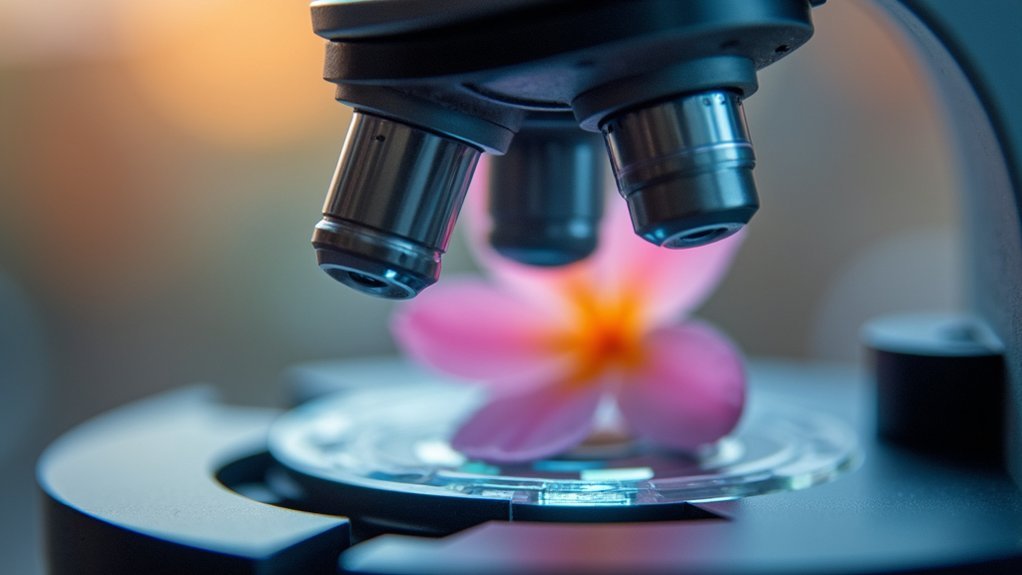Depth of field decreases dramatically as magnification increases because of the physics of light rays. When you magnify an image, the light rays enter at steeper angles, creating smaller circles of confusion around your focus point. This inverse relationship means doubling your magnification reduces focus depth by a factor of four. You’ll need techniques like focus stacking to overcome this limitation when shooting close-ups. The optical principles behind this relationship reveal fascinating solutions for macro photographers.
Why Does Focus Depth Change During Magnification?

When you increase magnification in photography, the depth of field considerably shrinks, creating a narrower range of acceptable focus around your subject. This relationship follows a mathematical pattern: doubling your magnification reduces focus depth by a factor of four.
This happens because magnification fundamentally alters the optical physics of your image capture. As you move closer to your subject or increase focal length, you’re effectively amplifying the separation between elements at different distances.
The relationship between subject distance and focal length directly impacts this magnification effect.
It’s worth noting that aperture settings aren’t the primary culprit here. Even if you maintain the same aperture while increasing magnification, your depth of field will still decrease considerably.
Understanding this inverse square relationship helps you anticipate and adjust for focus challenges during high-magnification photography.
The Physics of Magnification and Light Rays
To understand what’s happening when your depth of field narrows during magnification, you’ll need to examine the underlying physics of light ray behavior.
When you increase magnification—whether by using a longer focal length or moving closer to your subject—you’re changing how light rays converge at the focus plane.
Magnification fundamentally alters the convergence geometry of incoming light, transforming how your lens renders focus across the image plane.
Higher magnification causes these light rays to enter the lens at steeper angles, creating a smaller circle of confusion. This means fewer areas appear acceptably sharp around your focus point.
The relationship is exponential: doubling your magnification reduces depth of field by a factor of four.
This explains why macro photography and telephoto shots exhibit such shallow depth of field—the increased magnification dramatically narrows the range where objects appear sharp, forcing you to be more precise with your focusing.
Understanding the Inverse Relationship Between Magnification and Depth of Field

The inverse relationship between magnification and depth of field represents one of photography’s most essential technical principles. When you increase magnification, your depth of field decreases by the square of that increase—double your magnification and your focus range shrinks to one-fourth its original depth.
| Magnification Factor | DOF Change | Practical Application | Focus Management Requirement |
|---|---|---|---|
| 1x (standard) | Baseline | Normal photography | Standard techniques |
| 2x | 1/4 of original | Close-up portraits | Increased precision |
| 4x | 1/16 of original | Macro photography | Critical focusing |
| 10x | 1/100 of original | Extreme macro | Ultra-precise technique |
This relationship becomes even more pronounced when working with longer focal lengths or at close distances. In macro photography, this effect is so dramatic that aperture adjustments alone can’t compensate, making precise focus management your primary technical challenge.
Numerical Aperture and Its Role in Focus Depth
While most photographers focus primarily on f-stop values, understanding numerical aperture (NA) provides deeper insight into the optical physics affecting your focus depth during magnification.
NA is expressed as the product of the medium’s refractive index and the sine of the maximum light cone’s half-angle that can enter your lens.
Numerical aperture quantifies your optical system’s light-gathering capacity through the refractive medium and maximum acceptable light angle.
As you increase magnification, the effective numerical aperture rises simultaneously. This creates an inverse relationship: higher NA values collect more light but considerably reduce depth of field.
You’ll notice this when attempting to focus on minute details—your focus depth narrows dramatically, requiring more precise focusing technique.
This relationship is essential for achieving ideal image resolution in high-magnification photography.
When you’re working at substantial magnifications, even slight focus adjustments will greatly affect which planes appear sharp in your final image.
The Circle of Confusion at Different Magnification Levels

When you increase magnification in your imaging system, the Circle of Confusion grows exponentially—doubling your magnification quadruples the CoC size.
You’ll notice this dramatic size change affects how much of your subject appears acceptably sharp, as areas just slightly off the focus plane quickly blur beyond recognition.
This shift in perception threshold means that focusing becomes more critical at higher magnifications, requiring more precise adjustments to capture the details you’re seeking.
Circle Size Changes
As magnification levels increase, circles of confusion grow dramatically larger, transforming how depth of field behaves in your images. This isn’t a subtle effect—when you double your magnification, your depth of field decreases by approximately four times, severely limiting the zone of acceptable sharpness.
The physics behind this phenomenon is straightforward: at higher magnifications, light rays enter your lens at more oblique angles, making it harder for your optics to maintain consistent focus across the frame. Even tiny deviations from the focal plane become glaringly obvious.
You’ll notice this effect when shooting macro photography or using telephoto lenses. Understanding these circle of confusion changes helps you make better technical decisions about aperture settings and subject distance, allowing you to control which elements remain in focus despite the challenges of increased magnification.
Perception Threshold Shifts
The human eye’s ability to perceive sharpness fundamentally changes at different magnification levels, creating perception threshold shifts that dramatically impact your photography.
When you increase magnification, your acceptable Circle of Confusion size actually decreases, making smaller focus deviations more noticeable. This explains why your depth of field shrinks so rapidly—doubling magnification reduces your DoF by four times. What once appeared crisp now reveals its imperfections.
Your visual acuity determines these perception thresholds—what looks sharp at standard viewing distances may appear blurry under magnification. This relationship becomes critical in high-detail work like macro photography or when making large prints.
How Sensor Size Affects Depth of Field During Magnification
Sensor size plays an essential role in determining depth of field, particularly during magnification work. When you’re shooting with a full-frame sensor, you’ll achieve shallower DOF compared to crop sensors at identical apertures and distances. This effect becomes even more pronounced as magnification increases.
| Sensor Type | Magnification Effect | DOF Characteristic |
|---|---|---|
| Full-frame | Enhanced subject isolation | Noticeably shallower |
| Crop | Extended effective focal length | Relatively deeper |
| Medium format | Maximum background separation | Extremely shallow |
Your crop sensor effectively increases focal length, resulting in deeper DOF at the same aperture setting. This is why portrait photographers often prefer full-frame cameras—they create more pronounced background blur with better subject separation. Understanding this relationship helps you make informed equipment choices when you need precise control over focus areas in close-up photography.
Practical Applications in Microscope Photography

You’ll need specialized techniques like focus stacking to overcome the shallow depth of field challenges in microscope photography.
By capturing multiple images at slightly different focus points and combining them, you can create a single image with greater apparent depth of field than physically possible with a single shot.
Depth compensation methods, such as adjusting the aperture or using computational imaging algorithms, can further enhance your ability to document microscopic specimens with peak clarity throughout complex three-dimensional structures.
Focus Stacking Techniques
When working with microscopic subjects, focus stacking emerges as an indispensable technique to overcome the inherently shallow depth of field at high magnifications. By capturing multiple images at different focal planes, you’ll create a composite with extended focus that reveals details impossible to achieve in a single shot.
As magnification increases, precise alignment becomes critical. You’ll need to maintain consistent positioning while adjusting only the focus between shots. Most photographers rely on specialized software to align and blend these images automatically, eliminating potential artifacts.
Don’t overlook your lighting setup when stacking. Consistent illumination across all images prevents exposure variations that can compromise the final composite.
With proper execution, you’ll produce microscope images with remarkable clarity and detail, transforming otherwise limited views into exhaustive visual records of your specimens.
Depth Compensation Methods
Despite the inherent challenges of microscope photography, several practical depth compensation methods can greatly improve your results.
When working at high magnification, you’ll notice the depth of field drastically shrinks, making it difficult to capture your entire specimen in focus.
To counteract this limitation, increase your aperture value (higher f/#) whenever possible. This simple adjustment extends your depth of field, though it may require additional lighting.
For specimens with significant three-dimensional structure, implement focus stacking by capturing multiple images at different focus points, then combining them into a single sharp composite.
For peak image clarity, maintain precise distance calibration between your lens and specimen. Even slight adjustments affect magnification and focus depth.
These compensation techniques allow you to overcome the physical constraints of microscopy while preserving fine details throughout your subject.
Techniques to Maximize Depth of Field at High Magnifications
Since high magnification inherently reduces depth of field, photographers must employ specific strategies to maintain sharpness throughout their subjects.
Your first option is to increase your f-stop number, using a smaller aperture to extend your focus range. Remember that doubling your magnification reduces depth of field to just one-quarter of its original depth, so aperture adjustments become essential.
You can also step back from your subject to reduce magnification while maintaining composition.
For technical solutions, try focus stacking—capturing multiple images at different focus points and combining them for complete sharpness.
Though larger sensors typically create shallower depth of field, you can counterbalance this effect with smaller apertures to preserve detail across your high-magnification images.
Focus Stacking Methods for Extended Depth in Microscopy

Focus stacking represents one of the most powerful techniques in microscopy photography. When you’re dealing with specimens that have complex geometries, a single image simply can’t capture all details in sharp focus due to limited depth of field at high magnifications.
By combining multiple images taken at different focal planes, you’ll achieve remarkable clarity throughout your subject.
To implement effective focus stacking with your microscope:
- Capture 15-30 images with small, consistent focal length adjustments between each shot
- Ascertain your setup remains completely stable throughout the imaging process
- Maintain consistent lighting to prevent exposure variations that complicate alignment
- Use specialized stacking software that can correctly align and blend images while preserving critical details
This technique dramatically extends your effective depth of field, revealing intricate structures that would otherwise remain partially blurred.
Equipment Considerations for Optimal Focus Control
When selecting microscopy equipment for precise focus control, your optical system’s focal length characteristics should be your primary consideration. Shorter focal lengths deliver higher magnification but greatly reduce depth of field, requiring more precise focus adjustments to maintain clarity.
You’ll find that longer focal length eyepieces provide a more forgiving depth of focus, giving you greater flexibility during observations. Proper mounting of your scope is essential—inconsistent eye relief can compromise focus quality at varying magnification levels.
Consider fixed magnification optics when image quality is paramount. Their simplified optical mechanics eliminate focus discrepancies that often occur during magnification changes.
Remember that as you increase magnification, your depth of field decreases proportionally. This inverse relationship means you’ll need more careful focus management to achieve ideal viewing results.
Calculating Depth of Field in Microscope Photography
The mathematics behind depth of field provides essential insights for microscope photography. When calculating focus depth in microscopy, you’ll need to understand that DOF decreases exponentially as magnification increases. The formula DOF = (2 × λ × n) / (NA²) demonstrates how numerical aperture considerably impacts your results.
To accurately calculate depth of field in your microscope photography:
- Measure your microscope’s actual numerical aperture (NA) value for the objective lens you’re using.
- Factor in the magnification level, noting that doubling magnification quarters your DOF.
- Consider the wavelength of light being used—longer wavelengths provide slightly greater DOF.
- Calibrate calculations against standardized DOF charts specific to your equipment setup.
Understanding these calculations helps you anticipate focus challenges and plan appropriate techniques for your specimen imaging needs.
Frequently Asked Questions
How Does Depth of Focus Change With Magnification?
As you increase magnification, your depth of focus dramatically decreases. When you double the magnification, you’ll reduce depth of focus by four times, making it harder to keep subjects sharp without precise adjustments.
What Happens to the Depth of Focus as Magnification Increases?
As magnification increases, your depth of focus dramatically narrows. You’ll notice it decreases by a factor of four when you double the magnification, making precise focusing more critical and requiring better alignment of your equipment.
What Happens to Depth of Field When Magnifying?
When you magnify your subject, your depth of field decreases considerably. As you double the magnification, your depth of field shrinks by a factor of four, leaving less of your image in sharp focus.
What Is the Relationship Between Magnification and the Depth of Field?
As you increase magnification, your depth of field decreases dramatically—doubling magnification reduces DoF by a factor of four. It’s an inverse square relationship, which is why close-up photography requires careful focus consideration.
In Summary
When you increase magnification, you’re narrowing your depth of field—it’s an unavoidable optical trade-off. Higher magnification means light rays enter at wider angles, creating a smaller area of acceptable focus. You’ll need to adjust your techniques accordingly, perhaps employing focus stacking or specialized equipment. Understanding this relationship helps you anticipate focusing challenges and capture sharper images, even when examining minute details at extreme magnifications.





Leave a Reply